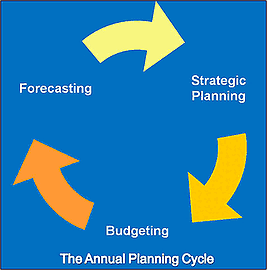It's that time of year again. Review the actuals, add 4%, and look at it bottoms-up, top-down, and in regard to operations vs. capital spend. Build some assumptions, work in a few numbers, consider what a reorg would do, and run some "what if" models. That's right, annual planning is upon us!
Budgeting and planning lay the foundation for continuous improvement of an organization's fiscal health. Nailing down the future state early on drives efficiency, improves planning and creates a shared vision for success. It is a critical component to transforming any finance organization, making the best use of critical data to inform key decisions and strategies.
Remember how you told yourself to set aside time after last year's cycle to fix the process and streamline activities so it would be better the next time around? Did you do it? Most organizations did not. Don't make the same mistake again, or you'll be reading this article next year as you pore over spreadsheets and forecasts at the holiday table.
While many organizations missed the boat on making wholesale improvements to their budgeting processes ahead of this year's cycle, there are still steps that can be taken this year to make a difference. Consider these six tips:
1. Automate. Are you getting the most out of your current tools? What are your current tools? In most organizations, they are spreadsheets, and the majority of Excel users take advantage of less than 5% of the package's features. It is worthwhile to sit down with an "Excel wizard" to walk through your budgeting and forecasting spreadsheets. Small changes can make a big difference in usability, accuracy and speed. Excel, Access and other end-user applications are powerful tools when used correctly and with the appropriate controls. Workflow, thresholding and data management tools can improve consistency and highlight focus areas for additional attention, but most organizations fail to use them effectively. Devote some time to improving templates, and consider every user receiving the benefits. Data is king when it comes to budgeting, but it is not an end goal in itself. Do not spend your time pulling together data and reconciling it -- spend your time building plans from it.
2. Focus on material items. Sure, it's fun to count paper clips, laptops and data plan costs at the employee level, but in the grand scheme of the enterprise budget, counting these items is a waste of time and unlikely to drive great improvement in business results. Instead, utilize driver-based metrics wherever you can in these areas (e.g., budget laptops based on employee counts rather than calculating them separately). Driver-based metrics are faster, more consistent and easier, plus they allow you to focus on areas where insight can truly improve business performance. That is the point of budgeting, after all.
3. Be honest. Many organizations budget at the department and line item levels, rolling up forecasts into summary reports and presenting them to management, only to be told that budgets have already been set and plans need to "deliver" certain contributions, regardless of the bottoms-up analysis. This is not to say that department heads should "Occupy Budget Street" in protest, but rather that both groups should consider the end product and needs from the outset and tailor the approach and workload to the reality that exists. Communication around expectations and end products will save time and effort, and result in happier budgeters all around.
4. Make time to do it right. Budgeting and setting plans -- and, most important, thinking about budget decisions and future direction -- is incredibly valuable if it is done right. If you are on the hook to budget for your department, sector, or business unit, block your calendar, close your door and think about what you are doing. Business planning is difficult to accomplish in fits and spurts. It is necessary to build a mental picture of how you see the business playing out, and then talk to others to get the full picture. For example, if the sales department assumes 20% growth in new revenue but does not share that goal, IT cannot envision or deliver the required systems.
5. Iterate. Budgets are often thrown together in the eleventh hour to meet artificial deadlines. No one likes this approach, and it does not achieve much in the end. An ideal budgeting process narrows broad goals into specific business plans and metrics through iterative group discussion, but only after initial metrics and numbers are generated by the groups responsible for each area. In a transformed organization, continually rolling forecasts update with actuals as the business proceeds against plan. In many successful organizations, initial budgets are reviewed during retreats or other gatherings, promoting dialogue and thinking, and providing a narrative to support the numbers. Three individuals will think three different things when viewing the same spreadsheet, so why not talk about it?
6. Review and improve. Set the meeting now to scrutinize this year's process and think through improvements for next year while the current pain points are fresh in your mind. Include reviews of both the process and enabling technology. Long term, consider upgrading to an enterprise-grade system with automated workflow and built-in controls.
Placing focus on planning and budgeting activities is a critical part of keeping financial processes healthy as businesses evolve. Finance transformation is best completed as a series of small steps, and this is one step that you can take now. In addition to making small but key changes to this year's process using the tips outlined above, open your calendar now and book time in January to stop, think and improve. The budget process does not have to be an annual pain point. Fix it.
Source: BusinessFinance Author: Bill Brydges
***
Interested in improving business processes and driving growth? Find out more about a solution for planning and budgeting here.
 English
English  Vietnamese
Vietnamese 

